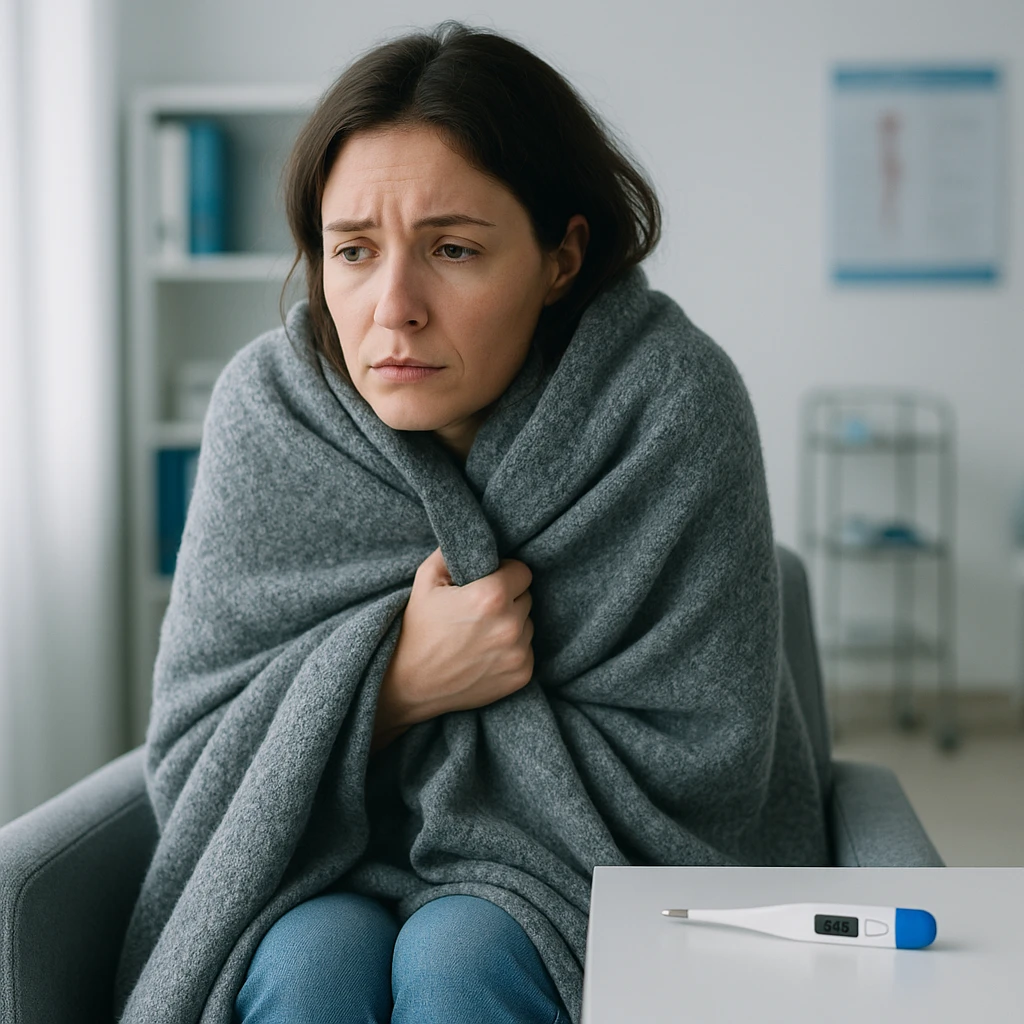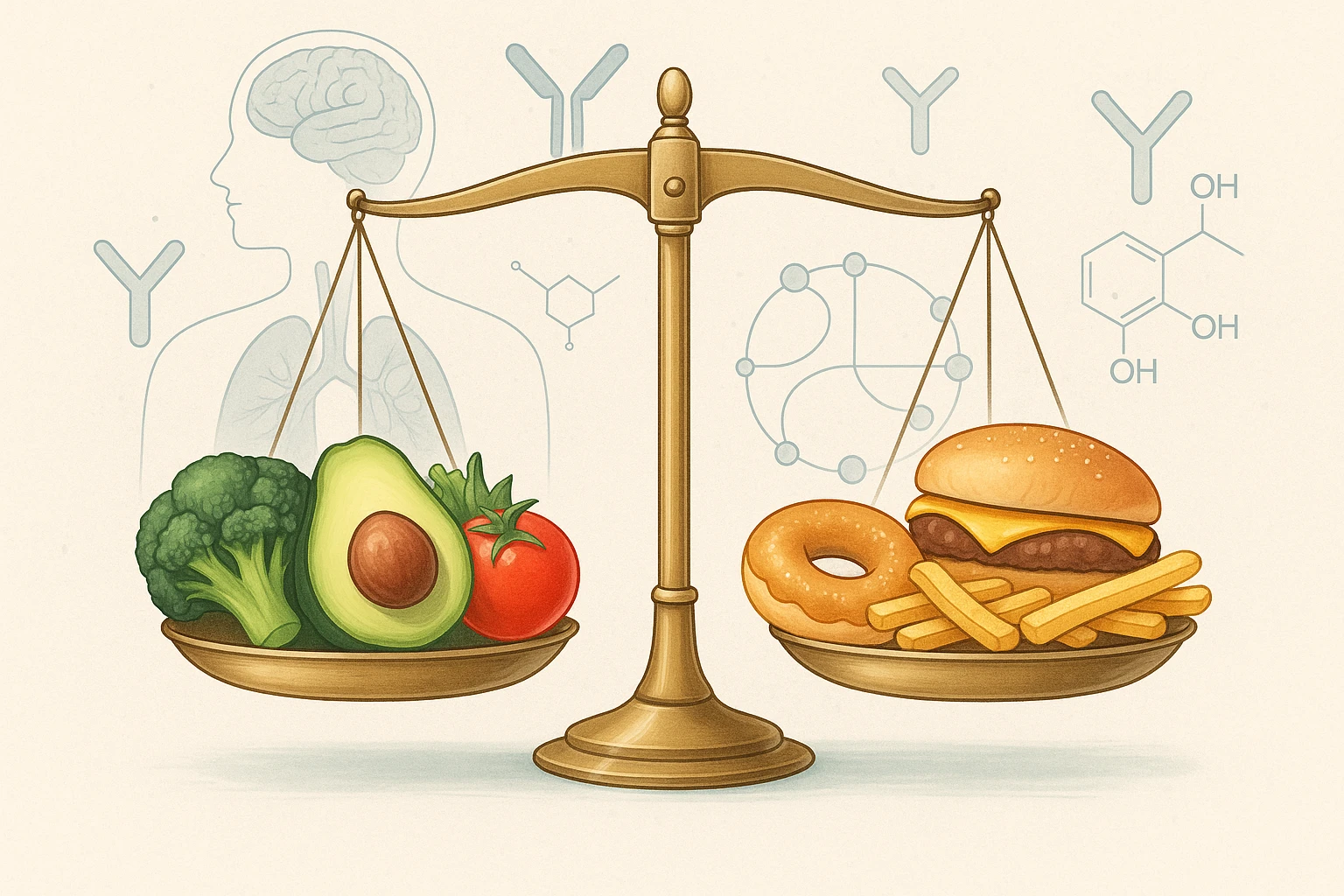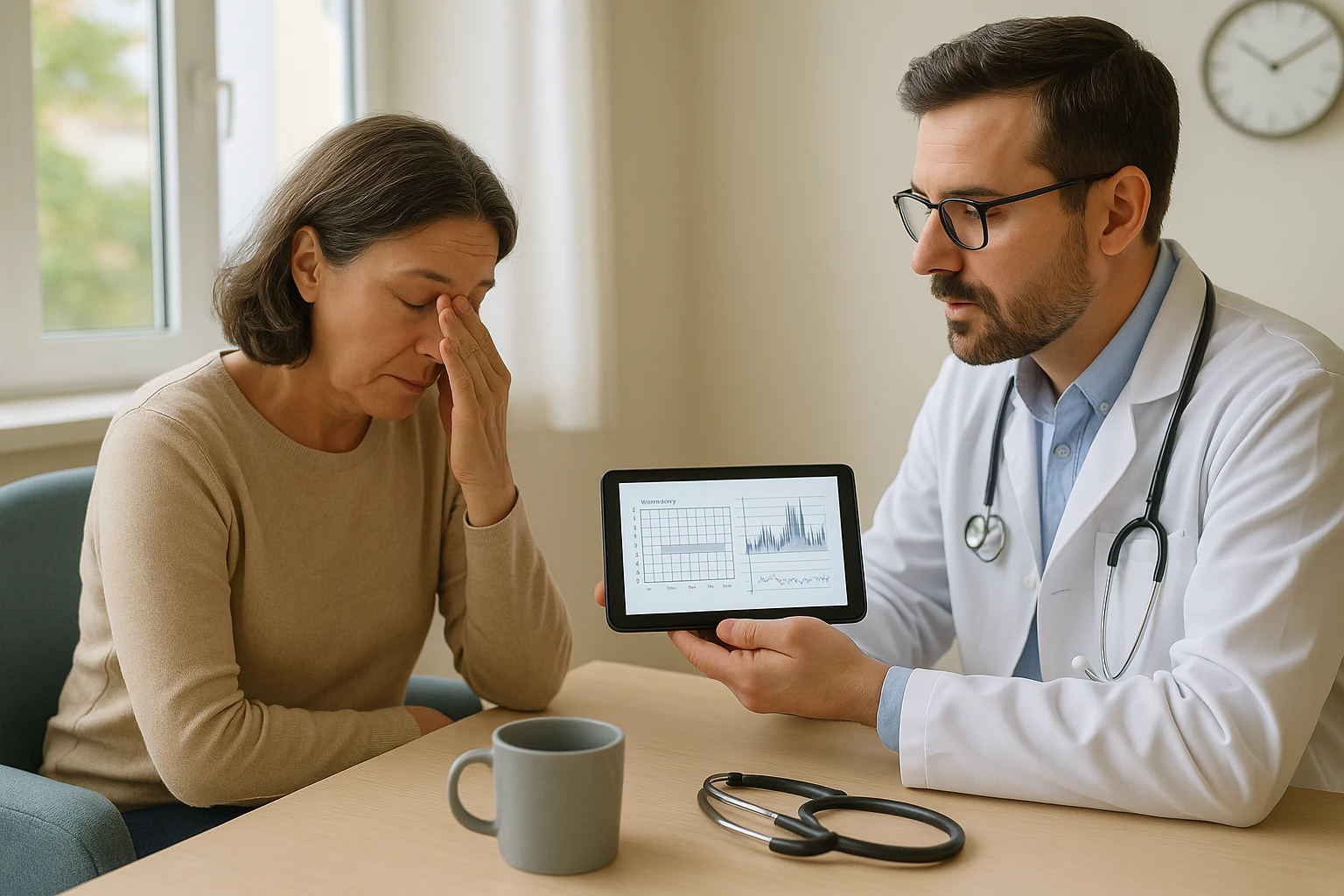Chills Without Fever: When to Worry and Seek Care
Chills Without Fever
Chills are a common physiological response that occur when the body attempts to generate heat through muscle activity. They consist of involuntary, rhythmic muscle contractions-known as shivering-that serve to increase core temperature through thermogenesis. Although chills often accompany fever, they can also appear when body temperature remains within normal limits, reflecting activation of the body’s thermoregulatory system in response to various stimuli.
Thermoregulation and Shivering Mechanisms
The human body maintains its internal temperature through a tightly regulated system controlled by the hypothalamus. When sensory receptors detect a drop in external or internal temperature, the hypothalamus triggers mechanisms to conserve and produce heat. One of the most effective short-term responses is shivering, which involves rapid, small-scale muscle contractions that release energy in the form of heat. This process, called thermogenesis, helps the body restore its optimal temperature range and protect vital organs from the effects of cold exposure.
- Hypothalamic regulation: Detects temperature changes and activates heat-producing responses.
- Muscle contractions: Rapid, involuntary movements generate heat through energy release.
- Thermogenesis: The process of converting stored energy into heat to maintain internal temperature.
Shivering also serves as an adaptive process that can occur even in mild temperature changes or under conditions where blood flow to the skin decreases. By converting stored energy into heat, this mechanism ensures temperature stability without requiring a systemic rise in body temperature.
When Chills Occur Without Fever
Chills may occur without fever when the body’s thermoregulatory centers perceive a mismatch between actual and desired core temperature. Environmental factors such as cold weather, damp clothing, or sudden temperature shifts can activate this response despite a normal internal temperature. Physiological stressors, including hormonal changes or metabolic fluctuations, may also transiently trigger shivering without a concurrent increase in core temperature.
- Environmental triggers: Cold weather, damp clothing, sudden temperature changes.
- Physiological factors: Hormonal shifts, metabolic changes, or reduced blood flow to the skin.
- Thermal mismatch: Perceived cold without actual hypothermia.
Understanding that chills without fever do not always signify infection is important in clinical interpretation. In many cases, they represent a benign thermal response rather than a sign of systemic illness. Recognizing these mechanisms helps clinicians and students differentiate between normal thermoregulatory reactions and those warranting further investigation.
Noninfectious Causes of Chills Without Fever
Chills that occur in the absence of fever often have noninfectious origins. These can result from environmental exposure, metabolic or endocrine imbalances, or hematologic conditions that affect the body’s ability to generate or retain heat. Understanding these mechanisms helps distinguish benign thermal reactions from symptoms that reflect underlying systemic disorders.
Environmental and Lifestyle Triggers
Exposure to cold weather, wind, or damp environments can cause chills even when body temperature remains normal. When the body loses heat faster than it can produce it, the hypothalamus activates shivering to restore balance. Wearing wet clothing or spending extended time in a cool environment accelerates this heat loss, leading to involuntary muscle contractions designed to generate warmth. Similarly, strenuous exercise may temporarily trigger chills during recovery as blood flow shifts from the skin to deeper tissues and the body attempts to reestablish thermal equilibrium.
- Cold or windy environments leading to heat loss
- Wearing damp or insufficient clothing
- Post-exercise chills during recovery
Endocrine and Metabolic Factors
Endocrine disorders, particularly hypothyroidism, are well-recognized noninfectious causes of chills and cold intolerance. Thyroid hormones play a vital role in metabolic regulation and heat production. In hypothyroid states, metabolic activity and energy expenditure decline, reducing the body’s capacity to generate heat efficiently. This impairment of cold-induced thermogenesis can make individuals more sensitive to mild temperature changes. Thyroid hormone replacement can restore this thermogenic response, highlighting its central role in temperature regulation.
Thyroid hormones also influence brown adipose tissue, which contributes to non-shivering thermogenesis-a metabolic process that generates heat without muscle contraction. When thyroid function is diminished, this pathway becomes less active, explaining why patients with hypothyroidism may experience persistent chills despite a stable core temperature.
| Endocrine Factor | Effect on Thermogenesis |
|---|---|
| Normal thyroid function | Activates brown adipose tissue and supports heat generation |
| Hypothyroidism | Decreases metabolic rate and impairs cold-induced thermogenesis |
| After thyroid hormone replacement | Restores thermogenic capacity and improves heat tolerance |
Hematologic and Nutritional Conditions
Hematologic factors such as anemia can contribute to chills without fever by impairing oxygen delivery and heat distribution throughout the body. Reduced hemoglobin levels limit oxygen transport to tissues, leading to decreased cellular metabolism and lower heat production. Nutritional deficiencies that affect red blood cell synthesis or energy metabolism may further compound this effect, resulting in a heightened sensation of cold or recurrent chills.
- Low hemoglobin reduces tissue oxygenation
- Decreased metabolism lowers heat generation
- Nutritional deficits further diminish thermogenic efficiency
Recognizing these noninfectious causes provides a more comprehensive understanding of why chills without fever can arise independently of infection. By considering environmental, endocrine, and hematologic mechanisms, clinicians can better interpret this common but often misunderstood symptom.
Infectious and Immune-Related Considerations
Chills without fever can sometimes indicate the early stages of infection or the body’s immune response before a temperature rise occurs. The absence of fever does not necessarily exclude infection, as thermoregulatory and immune processes can be activated at different times. Understanding this sequence is important for accurate clinical assessment, especially when other subtle signs of infection are present.
Early Infection and Cytokine Activation
During the initial phase of infection, the immune system releases cytokines and other inflammatory mediators that act on the hypothalamus, resetting the body’s thermal set point. This creates a temporary mismatch between perceived and actual body temperature, leading to shivering and chills as the body attempts to generate heat. These chills may appear before a measurable fever develops, serving as an early physiologic marker of immune activation.
- Immune activation triggers release of cytokines.
- The hypothalamic set point temporarily rises before fever develops.
- Shivering occurs to generate heat during this transitional phase.
Clinical Importance of Rigors
‘Shaking chills,’ medically termed rigors, are characterized by intense, uncontrollable shivering that may accompany systemic infection. Rigors are more specific than mild chills for serious bacterial infections such as bacteremia, though they are less sensitive and not present in all cases. Their occurrence should prompt clinicians to consider blood cultures and a broader infectious workup, even in the absence of recorded fever. Recognizing rigors as a potential sign of bloodstream infection supports early detection and appropriate intervention.
| Symptom | Clinical Significance |
|---|---|
| Mild chills | Common in early infection or immune activation |
| Rigors (shaking chills) | More specific for bacteremia or systemic bacterial infection |
| Persistent or severe rigors | May indicate sepsis and requires urgent medical evaluation |
Red Flags: When to Suspect Serious Infection
- Persistent or severe shaking chills
- Hypotension or low blood pressure
- Confusion or altered mental state
- Other systemic symptoms suggesting sepsis
Clinical Assessment and Patient Management
Evaluating a patient with chills without fever requires a structured approach. The aim is to determine whether the symptom reflects a benign thermoregulatory response or an early sign of systemic illness. A thorough history and focused examination help differentiate environmental, endocrine, hematologic, or infectious causes while identifying any urgent warning signs.
Initial Evaluation and Differential Diagnosis
Assessment begins with gathering detailed information about onset, duration, and context. Clinicians should ask about recent exposure to cold, wet, or inadequate clothing, and recent physical exertion. Medical history should include thyroid function, anemia, and other systemic disorders that impair heat generation or distribution. Inquiry into recent infections, medication use, and immune status provides additional diagnostic clues.
- Assess exposure to cold or wet environments
- Review thyroid, hematologic, and infection history
- Evaluate medication effects or immune suppression
- Perform focused physical examination for systemic clues
Recognizing Red Flags
Most episodes of chills are benign, but some require urgent medical review. Red flags include prolonged or severe shaking chills, confusion, dizziness, hypotension, or evidence of systemic instability. Persistent chills associated with weight loss, fatigue, or pallor should also raise suspicion for underlying endocrine or hematologic disorders.
- Severe or prolonged shaking chills (rigors)
- Confusion, dizziness, or low blood pressure
- Weight loss, fatigue, or pallor
- Signs of systemic instability or sepsis
Home Management and Monitoring
For mild, situational episodes of chills without systemic symptoms, self-care measures can restore comfort and prevent recurrence. Warming the body gradually through layering, blankets, and removal of damp clothing can reduce shivering. Avoiding prolonged exposure to cold or wet environments helps maintain normal thermoregulation. Individuals should monitor for any new or worsening symptoms, including fever, weakness, or mental status changes.
- Use warm clothing and blankets to restore temperature
- Replace damp garments promptly
- Limit exposure to cold environments
- Track new or worsening symptoms
When to See a Doctor
- Persistent or unexplained chills
- Dizziness or low blood pressure
- Confusion or altered consciousness
- Other systemic signs suggesting infection or organ dysfunction
Epidemiology and Diagnostic Integration of Chills Without Fever
Chills without fever are a frequent but nonspecific clinical presentation encountered across diverse populations. While often transient or environmentally induced, they can also reflect underlying metabolic or endocrine disorders. Recognizing their epidemiologic and physiological context assists clinicians in developing a structured, evidence-based approach to evaluation and management.
Population Context and Relevance
Among noninfectious causes of chills, hypothyroidism is a key endocrine contributor. Epidemiologic data indicate that mild or subclinical hypothyroidism affects a notable proportion of adults, with overt disease present in a smaller but clinically significant percentage. Because thyroid hormone regulates thermogenesis and energy metabolism, even modest hormonal deficiencies can produce cold intolerance or recurrent chills. Similarly, anemia-prevalent in both general and specific populations-can reduce oxygen transport and metabolic heat production, contributing to sensations of chilliness despite normal core temperature.
- Subclinical hypothyroidism: affects a notable proportion of adults
- Overt hypothyroidism: smaller but clinically significant percentage
- Anemia: decreases oxygen delivery and heat generation
Understanding these population trends helps frame the likelihood of endocrine or hematologic etiologies when patients report chills without other systemic symptoms. Integrating such context into clinical reasoning ensures that common, treatable causes are not overlooked.
Structured Diagnostic Pathway
Integrating physiologic understanding with clinical evaluation allows for a systematic approach to diagnosis. Initial assessment focuses on distinguishing between benign environmental triggers and pathologic processes. Key elements include detailed history-taking, evaluation of exposure to cold or damp conditions, and assessment for endocrine or hematologic risk factors. Persistent or recurrent chills, particularly when accompanied by fatigue, pallor, or weight changes, warrant laboratory investigation such as thyroid function testing and hemoglobin measurement.
| Diagnostic Step | Focus |
|---|---|
| History and exposure review | Identify environmental or lifestyle triggers |
| Physical examination | Evaluate for signs of endocrine or hematologic disorder |
| Laboratory evaluation | Assess thyroid function and hemoglobin levels |
This structured reasoning process links observed symptoms with underlying mechanisms. By combining environmental, metabolic, and systemic perspectives, clinicians can efficiently determine whether chills without fever are self-limited or signal a disorder requiring targeted management. The integration of epidemiologic awareness and physiologic principles thus forms the foundation for accurate, patient-centered diagnostic decision-making.
Frequently Asked Questions About Chills Without Fever
- Can chills occur without any rise in body temperature?
- Yes. Chills can happen even when body temperature is normal. They may result from temporary activation of the body’s heat-regulating system due to cold exposure, stress, or hormonal changes rather than infection.
- When should persistent chills without fever be checked by a doctor?
- If chills continue for several days, recur frequently, or appear alongside symptoms like fatigue, dizziness, or confusion, medical evaluation is recommended to rule out thyroid disorders, anemia, or early infection.
- Can anemia or thyroid problems make a person feel cold or shivery?
- Yes. Low hemoglobin or reduced thyroid hormone levels can slow metabolism and limit heat production, leading to cold intolerance or recurring chills even without a measurable fever.
- Is it normal to get chills after exercising or being outdoors?
- It can be. Post-exercise chills or shivering after exposure to cold, wind, or damp conditions are usually short-lived and related to heat loss and blood flow changes rather than illness.
- What distinguishes normal shivering from rigors or severe chills?
- Normal shivering is mild and short-term, helping restore warmth. Rigors involve intense, uncontrollable shaking that may suggest a bloodstream infection and should prompt medical evaluation.
- Can stress or anxiety trigger chills without fever?
- Emotional stress or anxiety can activate the body’s sympathetic nervous system, occasionally producing brief episodes of shivering or chills, but these typically resolve once the body relaxes.
- How do doctors investigate unexplained chills?
- Clinicians assess exposure history, thyroid and blood health, and possible infection signs. Tests may include thyroid function studies, blood counts, and sometimes imaging or cultures if an underlying disorder is suspected.
- Are home remedies effective for mild, noninfectious chills?
- Yes. Keeping warm with layers or blankets, replacing damp clothes, and avoiding prolonged cold exposure can relieve most mild chills. Monitoring for new or worsening symptoms ensures early detection of serious issues.
- Do hormonal or metabolic changes cause chills without fever?
- They can. Shifts in thyroid, adrenal, or general metabolic activity may reduce the body’s ability to generate heat, producing intermittent chills even when temperature readings are normal.
- What warning signs suggest chills might signal a serious condition?
- Seek medical help if chills are severe, persistent, or accompanied by low blood pressure, confusion, rapid heartbeat, or other systemic symptoms, as these may indicate infection or sepsis.













